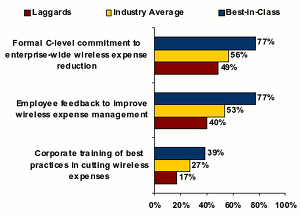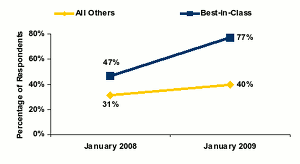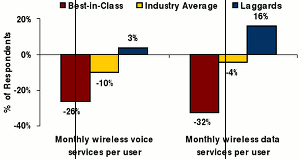
As mobile services become increasingly complicated and businesses look to find extra money, there is a technological solution that can offer companies peace-of-mind. The solution is known simply as “wireless expense management” (WEM), which has allowed some companies to save upwards of US$5 million in their yearly wireless expenses by making wireless bills less cumbersome.
WEM solutions take the enigma that exists through a corporate wireless program and tries to make sense of it all. What used to take many full-time employees poring through line after line of charges can now be handled much more efficiently through computer-based software programs. These programs allow more visibility into the telephonic infrastructure of a company, whether it be mobile feature phones, smartphones or even aircards, and they can track devices and usage.
“Wireless expense management is a specialized, often-overlooked set of processes and technologies that can help save a company money in its wireless bills,” said Hyoun Park, research editor in technology markets at Aberdeen Group. One way companies have found they can save money is by scheduling regular inventory and billing audits. This allows companies to gain visibility into their inventory and the line items that are being billed. “If you don’t audit your inventory regularly, you risk losing track of an ever-expanding list of assets and services,” said Park. “Especially as we’ve seen the number of smartphones increase throughout business.”
New Features, New Complexities
Because of smartphones, there are new sets of service delivery that were not available on previous bills. These services can include location-based services (LBS), mobile data connections, mobile applications, photo capabilities, and mobile messaging capabilities. As these charges have joined the already-numerous line items related to domestic voice, long distance, international roaming, text messaging, phone features, and related taxes and surcharges, wireless invoices have steadily grown in their size and scope — and not always in the interest of the company.
As smartphones replace more and more feature phones, many companies see a swell in mobile inventory as well the amount of line items being charged back to the company. Some of these charges are legitimate and should be charged back to the company. “By looking into these charges, companies can find legitimacy in an application downloaded onto the phone,” said Park. “But if the audit turns up that the application was something like a video game, not something that would be necessary to business, the company could take action to recoup the expense.” Prevention is still the best cure, as informed employees typically help lower the costs. “By providing corporate training of best practices, companies can improve their expenses throughout the enterprise and allow each individual user the ability to police their own behavior,” Park said.
By training employees (Figure 1) on the appropriate corporate policies with their wireless devices, employees can be held accountable for what they do with the device, much like there are policies pertaining to Internet access and computer use already in place in most companies. Individual end-user behavior is also an important component of acquiring wireless expenses because employee feedback is also vital to understanding the practices that are responsible for improving wireless expense management.
“In some cases, cutting expenses may be as simple as tracking information calls, curtailing text messaging, or replacing an international roaming cell phone with an appropriate pre-paid SIM card,” said Park. “By gaining employee feedback, these organizational habits can be altered to reduce costs.”
C-Level Support
In order to get these policies in the first place, there has to be formal commitment from C-level executives. This same commitment is needed throughout business whenever implementing new technology, and it is no different when implementing a WEM solution.
The top 20 percent of companies (Best-in-Class) using a WEM solution in the January study “Reducing the Cost of Freedom: Wireless Expense Management,” showed the importance of executive buy-in, which 77 percent of these organizations had, compared to 40 percent of the all others (Figure 2).
“What is impressive is how this rate has increased from last year to this,” said Park. “The level of executive buy-in for Best-in-Class companies has skyrocketed, while all other organizations have made a meager attempt.” In the end, the level of commitment from the top correlates closely to the success of the WEM solutions in Best-in-Class organizations versus all others.
“Reducing the Cost of Freedom” further outlines what abilities a company must have when approaching a solution and what must be executed in parallel in order to keep wireless expenses in check, said Park. The companies that have executed the placement of a WEM solution and have had success have been able to reduce their monthly wireless charges for both voice and data service much better than their counterparts (Figure 3).
“It isn’t simply that Best-in-Class companies [spend] $88 a month per user while Laggards were spending $116,” said Park. “It is that Laggards actually proved worse than companies without any sort of solution, proving that technology isn’t a save-all solution if it isn’t being leveraged correctly.” While Park believes that it is in most companies’ interest to introduce a solution as a way to save money in a fairly simple and easy way, he also believes the company must have a plan put into place to initiate such a solution.
To read more about how WEM solutions can help save businesses money and to obtain a complimentary copy of the report, please click here.
Andrew Stamer is an Aberdeen Group research associate for technology markets.




















































Thanks! Having gone through years of cell phone bills myself, I can appreciate both the pain of sorting these bills and the rewards of properly optimizing them. This is definitely a rising industry both because of the increase of smartphone complexity and the need to cut operational costs.
Hyoun Park
Twitter: hyounpark_AG
Great article, and it’s right on the money–I would know as I work in the Wireless Expense Management industry for a company called Validas. Through Validas’s website, http://www.fixmycellbill.com, we slash the average cell bill by 22 percent and work for both companies and individual consumers. We have been profiled in the national news media, most recently on Good Morning America (http://www.abcnews.go.com/GMA/story?id=6887412&page=1), but it’s great to see someone taking note of the Wireless Expense Management industry as a whole entity rather than just viewing it as limited to individual companies. Nice job!